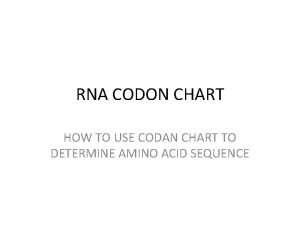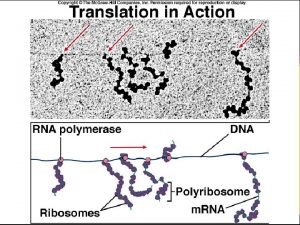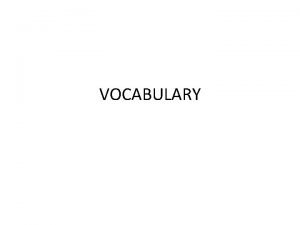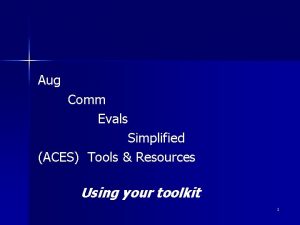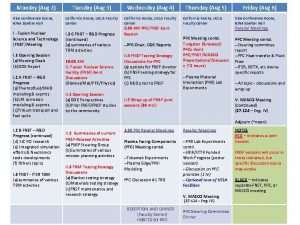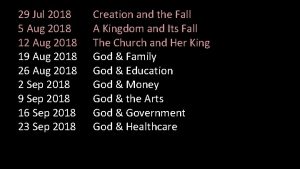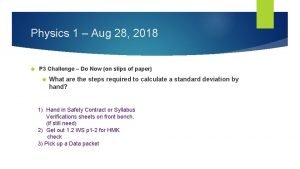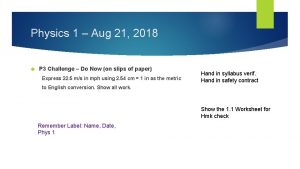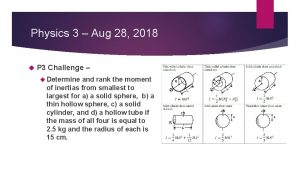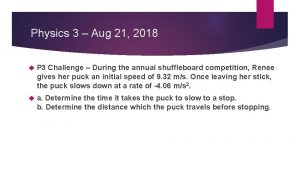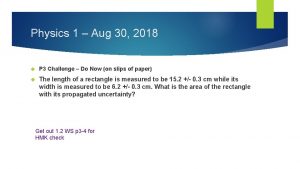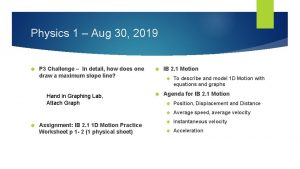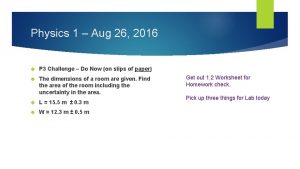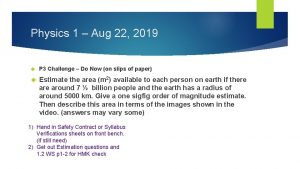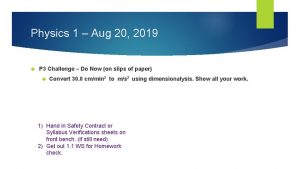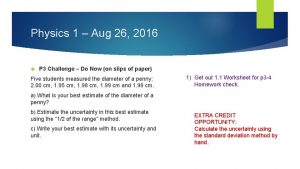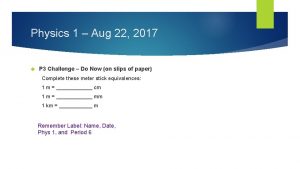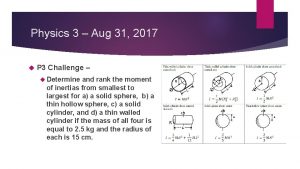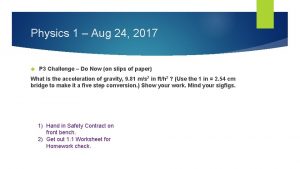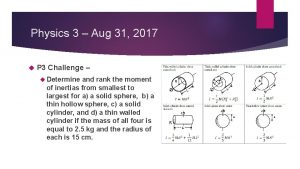Physics 1 Aug 17 2018 P 3 Challenge




















- Slides: 20

Physics 1 – Aug 17, 2018 P 3 Challenge – Do Now (on slips of paper) Complete these meter stick equivalences: Hand in syllabus verif. Hand in safety contract 1 m = _______ cm 1 m = _______ mm 1 km = ______ m Remember Label: Name, Date, Phys 1 Pick up the 1. 1 Worksheet

Physics Overview Mechanics Electromagnetism Optics Gravity Physics Cosmology Atomic/Nuclear Thermodynamics Applied

Physics Overview Energy – Relates to all other aspects Kinematics Dynamics Mechanics Electromagnetism Optics Relativity Gravity Atomic/Nuclear Particle Physics Cosmology Thermodynamics Applied Engineering Astronomy Biophysics / Chemical Physics

Objectives IB 1. 1 Measurement in Physics --- Standard Operating Procedures State the fundamental units of the SI system Be able to express numbers in scientific notation Appreciate the order of magnitude of various quantities Perform simple order-of-magnitude calculations mentally Express results of calculations to the correct number of significant figures.

Agenda for IB 1. 1 Measurement in physics – Standard operating procedures About Numbers Standards Measuring Metric units Significant figures Unit conversion Scientific Notation Dimension Analysis Calculations with sigfigs Estimation Assignment: IB 1. 1 Measurement in Physics Practice Sheet, Pages 1 -4

Exact and Inexact Numbers (Math vs Science) Counting items gives an exact number (e. g. 12 apples = exactly 12 apples) Definitions within a measurement system give exact numbers (e. g. exactly 12 inches = exactly 1 foot, by definition) Measurements give inexact numbers (e. g. 5. 7 m) with some amount of uncertainty. In science, we don’t use fractions. Conversion factors between systems of measurements give inexact numbers. (e. g. 1 lb = approximately 0. 4536 kg…give or take a bit)

How to measure Uncertainty depends on the measurement device used and on how it is used to measure. Identify the smallest gradation marked on the measurement device. Measure to this level of precision (certain measurement) Add one more digit as an estimation of the true measurement’s location between the smallest gradation marks. (source of uncertainty) Try to decide on one of the five statements below. If you can’t decide between two statements, use the odd digit between. 0 right on the line, 2 just above the line, 4 almost halfway, 6 a little more than halfway, 8 nearly to the next line.

Practice

Determining Significant Figures Significant figures (digits) –the digits that are known with certainty plus one digit whose value has been estimated in a measured value. How to determine the number of sig figs: The digits of a measured number indicate the level of precision for the measurement. All non-zero numbers are significant. Leading zeros are never significant. Confined zeros are always significant. Trailing zeros are significant if and only if a decimal point is present. Ambiguous numbers like 300 m. L can be made clear by using a decimal point, a line over the last significant digit, or using scientific notation.

Practice identifying sigfigs 40. 7 L 0. 095 250. 87 987 m cm 009 km 85. 00 g 9. 000 000 mm 0. 0009 2000 kg cm

Scientific Notation A clear way to report numbers that are either very large or very small, or numbers with an ambiguous number of significant figures Two parts: Mantissa x 10 exponent Mantissa, or decimal part, is a number with one non-zero digit to the left of the decimal point that contains all significant digits, and only significant digits Exponent indicates the decimal place location for the digits. Exponent = number of places the decimal point must move to be placed to the right of the first significant figure Large numbers have positive exponents and small numbers have negative exponents. 2000 cm 2. 00 x 103 cm makes the significance clear. Use Sci Not if you need clarity or you need to use more than 3 zeros.

Multiplication/Division with Significant Figures (also power and roots) Perform the calculation indicated. Round your answer to the same number of significant figures as the number with the least number of significant figures that was used in the calculation. DO NOT report all digits shown in your calculator Round down for 4 or below. Round up for 5 and above. Ex: 1. 92 m x 11. 53 m = 22. 1376 m 2 (If a large set of data ends in 5’s, rounding up on all fives can introduce an error. In these cases, apply the odd-even rule for the digit just before the 5, Even rounds down, Odd up. )

Addition/Subtraction with Significant Figures Perform the calculation indicated. Round your answer to the same number of decimal places as the number with the least precise decimal place that was used in the calculation. Decimal places (place value) – the number of digits after the decimal point DO NOT report all digits shown in your calculator The number of significant figures may increase or decrease. Hint: Remove any scientific notation, then add/subtract numbers vertically. The place with a significant digit for all numbers is the place to round your answer. Ex: 0. 92 m + 1. 503 m = 2. 423 m

Multistep problems with mixed functions In general, keep extra digits for intermediate results, while at the same time noting which place is significant by underlining that digit. Ex: 3. 252 (0. 125 + 1. 30) Ex: 3. 252 (550 + 82. 2) Ex: 3. 252 x 0. 125 + 1. 30 Ex: 3. 252 x 550 + 82. 2 Often it is easiest to just not clear your calculator for intermediate results. Rule of thumb: Follow significance throughout, but don’t round until the end.

Unit Conversions (Factor-Label method) “Times sign, draw the line, copy the unit. ” Variations on theme Multistep conversions Metric conversions using prefixes Metric to English conversions Squared unit conversions Ratio unit conversions 1 m = 100 cm 1 m. L = 1 cm 3 = 1 cc 1 m = 1000 mm 1 g of water = 1 m. L 1000 m = 1 km applies to L and g also

Multistep conversions “Times sign, draw the line, copy the unit. ” If you do not know of the equivalence between the measured unit, and the target unit, consider a third unit that has an equivalence with both. Ex: convert 4. 75 miles to inches foot mile 4. 75 miles 5280 1 feet miles inch 12 inches 1 foot = 300960 inches = 301000 inches = 3. 01 x 105 inches

Metric to English conversions You need to know at least one conversion between English and metric for each type of quantity. These are the ones I recommend you memorize. Length: 1 inch = 2. 54 cm Mass: 1. 0 pound = 454 g Volume: 1 quart = 0. 946 L Ex: What mass in kg corresponds to a 2. 7 ton cargo crate? (use scientific notation for your answer)

Squared unit conversions If a unit is raised to a power, often 2 or 3, to perform a conversion, you must raise the entire conversion factor to that power. Convert 22 cm 2 to in 2 1 in 22 cm 2 2. 54 cm • Ex: 450 m. L to dm 3 2 = 3. 4 in 2

Ratio unit conversions Many derived units involve ratios of units. Mi/h, km/hr, m/s 2… If a unit on the bottom needs to be converted, “copy the unit” to the top. Ex: Convert 25 m/s to km/h 25 m 1 s meter km s min hr 1 km 60 1000 m 1 s min 60 min 1 hr = 90. km/hr

Today’s Assignment What’s Due on Thurs Aug 21? (Pending assignments to complete. ) Safety Contract Signed by Student and Parent/Guardian, Syllabus Verification IB 1. 1 Measurement in Physics Practice Sheet, Pages 1 -4, except estimates What’s Next? (How to prepare for the next day) Read IB 1. 2 p 7 -20
 Rna chart
Rna chart Translasjon
Translasjon Kaligirang pangkasaysayan ng el filibusterismo 1891
Kaligirang pangkasaysayan ng el filibusterismo 1891 Amo root words
Amo root words Aug q
Aug q Aug methionine start codon
Aug methionine start codon Aug comm device
Aug comm device Whitchester house
Whitchester house Cfa institute
Cfa institute B a f c j e
B a f c j e Modern physics vs classical physics
Modern physics vs classical physics University physics with modern physics fifteenth edition
University physics with modern physics fifteenth edition Physics ia rubric
Physics ia rubric Good morning team
Good morning team Tennis ball bounce height experiment
Tennis ball bounce height experiment Insecure cryptographic storage challenge 3
Insecure cryptographic storage challenge 3 Tower of books challenge
Tower of books challenge Egg drop contest
Egg drop contest Global management challenge
Global management challenge Good morning reported speech
Good morning reported speech Summer sport challenge
Summer sport challenge
